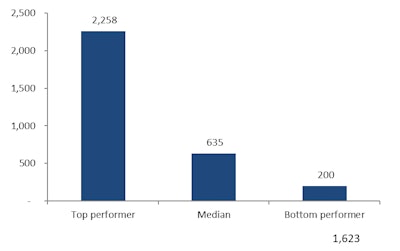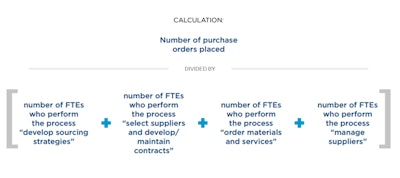
Staff productivity is an important factor in determining the performance of procurement. One productivity key performance indicator for the procurement process is the total number of purchase orders processed per procurement full-time equivalent employee (FTE). This metric includes both manual and electronic forms of purchase orders. Ideally, the more purchase orders a procurement professional can manage, the fewer people (and labor dollars) are needed to support this tactical function.
As shown in Figure 1, data from APQC’s Open Standards Benchmarking® in procurement shows that top performers process more than 11 times more purchase orders per procurement FTE than organizations performing at the lowest quartile. Since this measure looks at faster throughput, it is important to also look at a balanced scorecard of measures including quality assurance measures to ensure that the drive for speed does not result in increased errors.
Processing purchase orders has historically been a labor-intensive process. As such, many leading organizations have turned to technology, such as e-procurement, to increase productivity. Organizations are using e-procurement to buy both direct and indirect materials to leverage volume discounts, consolidate buying, and decrease labor costs. Additionally, organizations that implement a formal supplier approval process report the ability to process 72 percent more POs per procurement FTE.
Standardizing procurement processes increases performance by making it easier to place orders consistently. Standardization eliminates process overlaps and ineffectiveness by reducing complexities and implementing enterprise-wide standards. Once that occurs, e-procurement and other smart systems can automate non-value-added tasks, allowing the organizations to process a greater volume of purchase orders per FTE in procurement.
Calculation

This metric is calculated as shown in Figure 2 with the number of purchase orders placed divided by the sum of (number of FTEs who perform the process “develop sourcing strategies” + number of FTEs who perform the process “select suppliers and develop/maintain contracts” + number of FTEs who perform the process “order materials and services” + number of FTEs who perform the process “appraise and develop suppliers”).
To calculate FTEs involved in this process, assume that a full-time employee represents 40 hours per week, and calculate the percentage of that employee’s time allocated to a particular process. For example, if an employee spends only 25 percent of his or her time on a process, that would equal 0.25 FTE allocated to that process.
About This Process Group
The APQC Process Classification Framework® is a generic taxonomy of all organizational operating and support processes. The PCF is organized hierarchically into categories, process groups, processes, and activities. PCF Category 4.0 is “Deliver Physical Products.” APQC decomposes category 4.0 into four process groups, the second of which is “Procure Materials and Services” (PCF 4.2). This process group is comprised of four processes: develop sourcing strategies, select suppliers and develop/maintain contracts, order materials and services, and manage suppliers.
About APQC
APQC helps organizations work smarter, faster, and with greater confidence. It is the world’s foremost authority in benchmarking, best practices, process and performance improvement, and knowledge management. APQC’s unique structure as a member-based nonprofit makes it a differentiator in the marketplace. APQC partners with more than 500 member organizations worldwide in all industries. With more than 40 years of experience, APQC remains the world’s leader in transforming organizations. Visit us at www.apqc.org, and learn how you can make best practices your practices.















